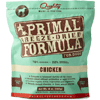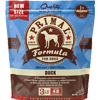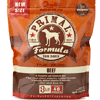Your dog's health is only as good as the foods he eats. Potentially toxic substances can be introduced to your dog's diet without you even knowing. Hormones, antibiotics, pesticides and preservatives may have degenerative effects on your dog's health.
When you purchase raw frozen or fresh meat, make sure the package states it's Hormone and Antibiotic free. If it doesn't state it on the packaging or if the cost of the meat is under $3 a lb or if the pet store tells you it's restraunt grade meat. It most likely contains Hormones and Antibiotics.
Antibiotics
The mass-production environment at stockyards and poultry factory farms make animals susceptible to numerous illnesses. This in turn calls for large quantities of antibiotics to keep the animals alive until they're slaughtered for food. Because there is no comprehensive recording program for food animals in Canada, there is no accurate assessment of what antibiotics are being used or in what quantities and for what reasons. Without enforcement of antibiotic usage within the industry, there is no way to track antibiotic application or withdrawal periods of drugs. The consequence of the overuse of antibiotics in the meat industry is that anyone or their dog eating the meat may end up harboring antibiotic residues.
Antibiotics are supposed to benefit consumers by providing healthier meat. Producers claim that if antibiotics were eliminated, the cost of meat to consumers would increase and the production costs incurred would be even higher. But the drugs aren't being used to only treat illness or control bacterial outbreaks. In cattle, they are used to reduce the incidence of bloat and acidosis due to an unnatural diet. They're also being used to promote growth. For instance, the poultry industry uses antibiotics to make chickens grow bigger at a faster pace. The debate as to whether antibiotics actually end up in the food chain is ongoing, with organic proponents saying that these drugs do not pass through the animals systems, but actually accumulate in the fatty tissues.
The Institute of Medicine (IOM) a division of the National Academies began to question the use of antibiotics in feed animals in 1989 when they identified antibiotic-resistant bacteria as a hazard to health. Resistance is a well-understood phenomenon. Not all bacteria are affected the same way by antibiotics; some bacteria are genetically able to resist the killing effects of an antibiotic. As a result, when bacteria are treated with an antibiotic, some resilient microbes survive. These resistant bacteria reproduce and the next time they are treated with the same antibiotic, the resilient survive again. Eventually, the only surviving bacteria are immune to that particular antibiotic. They have developed "resistance," and that antibiotic has lost its effectiveness against those bacteria. As time passes, some bacteria can develop resistance to multiple antibiotics. These bacteria are referred to as "multi-drug-resistant strains" and they are a serious medical concern. The bottom line is that conventional antibiotic drug therapy may not produce beneficial results should your dog require it for medical purposes.
Modern animal factories are home to thousands of chickens,
cattle and pigs. The animals are physically jammed
together so an outbreak of disease can pass readily from animal
to animal. To prevent this from happening and to promote
rapid growth, the animals are regularly treated with antibiotics.
If your dog must take antibiotics in addition to his regular meat consumption, he may be doubling up on his intake of these drugs. While one of the purposes of antibiotics is to kill bacteria, they also kill off the beneficial strains of bacteria within the body. These friendly bacteria act as the first line of defense against viruses, fungi, and other disease-producing microbes. An unnatural balance of unfriendly bacteria produces symptoms such as gastrointestinal upset, diarrhea, yeast and skin rashes.
Equally noteworthy are the side effects of antibiotics, which in a sensitive individual may result in diarrhea, nausea, vomiting, abdominal pains, swelling, wheezing, itching, increased sensitivity to the sun, vision changes, seizures, mental/mood changes, easy bruising or bleeding, irregular heartbeat, yellowing eyes and skin, and yeast infection. Feeding raw meats that contain residues of antibiotics could be cause for concern, especially if any of these symptoms are present in a pet consuming meat from intensive production systems. Over the long term, trace amounts of antibiotics ingested through food may overload your dog's system and open the way for disease.
Hormones
A high percentage of livestock raised for meat are given hormones to increase their weight gain and growth. Combining growth-promoting feed additives with ear implants is one of the most cost effective management tools available to producers. Anabolic steroids, in the form of small time-release pellets, are implanted in the animals' ears. The hormones slowly release into the bloodstream, increasing hormone levels by two to five times. Cattle are given estradiol, testosterone, and progesterone. The hormones stimulate cells to synthesize additional protein, adding muscle and fat tissue more rapidly. Hormones improve weight gain by 5 to 20 percent, feed efficiency by 5 to 12 % and lean meat growth by 15 to 25%. Over 95 percent of all feedlot-raised cattle are administered growth-promoting hormones. Estradiol or Zeranol and/or Trenbolone or Testosterone are used in castrated males, Testosterone or Trenbolone in young female cattle and adult cows.
Growing scientific evidence highlights the dangers of exposing people to hormones. Hormone residues in meat may disrupt the body's natural hormonal balance. Hormones found in meat and meat by-products also affect the dog's glandular regulatory system. Any disruption of this equilibrium can result in multiple biological effects with potentially harmful consequences for health. In view of the intrinsic properties of hormones discovered in recent scientific findings, Canadian meat consumers may be exposed to unnecessary risk from the intake of hormone residues. Scientifically speaking, these risks could include developmental effects, immunotoxicity, reproductive and immunological effects, genotoxicity and carcinogenicity. Although this information is directed at human health, it also translates to your dog. Unfortunately, the chemical residues in meat do not distinguish between one living being and another.
Pesticides
A pesticide is any substance or mixture of substances intended for preventing, destroying or repelling any pest. Pests can be insects, animals, plants, fungi, or microorganisms like bacteria and viruses. The term pesticide also applies to herbicides, fungicides, and various other substances used to control pests. By their very nature, most pesticides create some risk of harm to humans, animals or the environment because they are designed to kill or otherwise adversely affect living organisms.
In some areas, pesticide contamination has created far-reaching implications. Increased evidence points to widespread impacts on wildlife, including enlarged thyroids, cancers, deformed bills, and the feminization of male animals. This characteristic of many pesticides is now identified as "endocrine disruption".
Pesticides are sprayed on vegetables, fruit and all crops unless organically or naturally grown. Residues are not only on the plants, but in meat as well. Pesticide residues have been implicated in liver disease, cancer, infertility and many immune system and allergic diseases. Factory farm animals have very high concentrations of toxic chemicals from a lifetime of eating feed that has been sprayed with pesticides. Agri-business uses herbicides to kill weeds, insecticides to kill bugs on meat animals and fungicides to keep crops fungus-free & all the way to your dog's bowl.
Modern agriculture has introduced a variety of toxic substances to livestock production. The level of harm from exposure to animal antibiotics and hormones is dose related; the more your dog consumes the greater the potential risk. Besides making sure your dog is fed a superior diet that provides all the nutrients he needs to function optimally, you must limit the possibility of toxic residues when possible.








